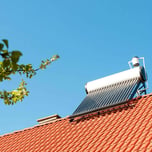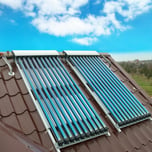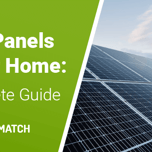
Get up to 4 quotes by filling in only 1 quick form

Slash your energy bills by installing solar panels

We’ve helped over 500,000 homeowners reduce their carbon footprint
- GreenMatch
- Solar Energy
- Solar Thermal
- Thermodynamic Panels
Thermodynamic Panels
Renewable energy sources have improved the lives of many in the UK, and they continue to do so as more people embrace them. Thermodynamic panels are one of these alternative energy sources that are still relatively new to the British market, yet have already made a name for themselves thanks to their efficiency and reliability, as well as their ability to operate in conditions which are unsuitable for solar thermal collectors, for example, at night or during wintertime.
In this article, we’ll discuss everything about thermodynamic panels, including their costs (and how much you can save), as well as how to operate and maintain them.
If you’re mainly interested in saving on your heating bills, thermodynamic panels are the perfect fit for you. If you would also like to save on the upfront costs, then comparing quotes can help you find the best deal.
Click the button below and fill in our short form to get up to 3 personalised quotes from our trusted thermodynamic panel suppliers. This way, you can easily compare offers and select the best deal. Our service is free of charge and does not impose any obligations.
- Quotes from local engineers
- Payment by finance available
- Save up to £729 per year
It only takes 30 seconds



- Thermodynamic Panels
- Cost-Effective Water Heating Using Thermodynamic Panels
- How Much Do Thermodynamic Panels Cost?
- How Much Money Can You Save?
- Where Can Thermodynamic Panels Be Installed?
- What Types of Mounting Systems Are Available?
- How Do You Operate the System?
- What Maintenance Is Required?
- Find the Best Thermodynamic Panel Suppliers
Cost-Effective Water Heating Using Thermodynamic Panels
A thermodynamic water heating system is a simple solution for reducing heating and gas bills. Only a heat collector panel and a compressor need to be installed and connected to your already existing hot water tank, and the system is already up and running.
The technology behind thermodynamic panels is based on simple heat exchange. Similar to air-to-water heat pumps, the heat from the ambient air is collected through a special fluid that and, with the help of a compressor, heats up the tank for domestic hot water. This results in a very low-cost source for hot water for your kitchen and bathroom sinks, tubs and pools, and other appliances.
How Much Do Thermodynamic Panels Cost?
Thermodynamic panels are sold for a reasonable price of £5,000 to £6,000, including the panel, components, and installation cost of panels for a family house of four people. Minimal to no maintenance costs ensure that the system will provide a steady return rate over the years.
Operating costs are also low as only the thermodynamic water heating system’s compressor needs electrical power. Under normal conditions, the compressor uses 360 watts an hour, equating to the consumption of a larger fridge. The amount of electricity used by the compressor, however, varies constantly, depending on the weather, time of day, month, and water usage, but remains efficient at all times.
Generally, with an average domestic water usage, the compressor only costs £8-10 per month or £96-120 a year to operate. Even heavy usage, like keeping the thermodynamic heating system on 24/7 would not cost more than £14 a month or £168 a year. If in combination with the thermodynamic panels a solar panel is used for generating the required electricity, the operating costs can technically be eliminated.
If the compressor is set to only operate between certain hours, for example during the hours when the ambient air is the hottest (11 am. until 5 pm.), the weekly electricity usage can be lowered below £4 a month or £48 a year, without causing much inconvenience.
How Much Can You Save?
Just how investment in solar panels provides a solid rate of return, thermodynamic panels are even more worth your money. Among the numerous domestic hot water solutions, thermodynamic panels are the cheapest to operate.
Operating Costs of Different Heating Systems
| Thermo-dynamic panel | Electric Boiler | Electric Immersion Heater | Heating Oil | Bottled Gas | LPG Gas | Mains Gas | Cost per unit |
|---|---|---|---|---|---|---|---|
| 2.5 | 12.0 | 30.0 | 6.0 | 32.0 | 7.5 | 4.5 | pence / kWh |
| 30 | 144 | 360 | 72 | 384 | 90 | 54 | pence / day |
While the initial investment is higher, thermodynamic water heating systems may cost over 10 times less to operate than other common types, such as electric immersion heaters. Actually, the cost of using a thermodynamic system is lower than all the most common water heaters.
The average household of 4 consumes 12 kWh a day on hot water. This includes baths or showers for everybody, washing the dishes, and other general hot water usage. This equals to a yearly consumption of 4,380 kWh. For such a number, it is very important that the water heater has the lowest possible operating cost per kWh of heating, as costs quickly add up.
Taking into consideration the price of the components, the installation costs, the heater’s lifespan, and the average daily hot water usage, thermodynamic panels usually reach their break-even point within 5 years compared to electric immersion heaters. Thermodynamic panels compete well with heating oil and LPG too, as within 15 years, the total costs are returned, which is actually the lifespan of such heaters, that is, by the time the investment in thermodynamic water heating is returned, oil and gas heaters already needed a complete replacement.
Savings with Thermodynamic Panels Compared with Other Heating Systems
The following table details how much you can save by installing thermodynamic panels, calculating with the unit price, installation, and operating costs.
| Year | Electric Boiler | Electric Immersion Heater | Heating Oil | Bottled Gas | LPG Gas | Mains Gas |
|---|---|---|---|---|---|---|
| 1 year | -2,993 | -3,644 | -1,889 | -1,815 | -2,888 | -3,019 |
| 2 years | -2,576 | -2,439 | -1,734 | -522 | -2,668 | -2,931 |
| 3 years | -2,158 | -1,233 | -1,580 | 772 | -2,448 | -2,842 |
| 4 years | -1,741 | -28 | -1,425 | 2,065 | -2,228 | -2,753 |
| 5 years | -1,324 | 1,178 | -1,271 | 3,358 | -2,008 | -2,665 |
| 6 years | -907 | 2,384 | -1,117 | 4,651 | -1,787 | -2,576 |
| 7 years | -490 | 3,589 | -962 | 5,944 | -1,567 | -2,487 |
| 8 years | -72 | 4,795 | -808 | 7,238 | -1,347 | -2,398 |
| 9 years | 345 | 6,000 | -653 | 8,531 | -1,127 | -2,310 |
| 10 years | 762 | 7,206 | -499 | 9,824 | -907 | -2,221 |
| Needs replacement | ||||||
| 11 years | 2,769 | 8,562 | -345 | 11,117 | -687 | -2,132 |
| 12 years | 3,186 | 9,767 | -190 | 12,410 | -467 | -2,044 |
| 13 years | 3,604 | 10,973 | -36 | 13,704 | -247 | -1,955 |
| 14 years | 4,021 | 12,178 | 119 | 14,997 | -27 | -1,866 |
| 15 years | 4,438 | 13,384 | 273 | 16,290 | 193 | -1,778 |
| Needs replacement | ||||||
| 16 years | 4,855 | 14,590 | 3,384 | 19,475 | 2,306 | 203 |
| 17 years | 5,272 | 15,795 | 3,539 | 20,768 | 2,526 | 292 |
| 18 years | 5,690 | 17,001 | 3,693 | 22,062 | 2,746 | 381 |
| 19 years | 6,107 | 18,206 | 3,848 | 23,355 | 2,966 | 469 |
| 20 years | 6,524 | 19,412 | 4,002 | 24,648 | 3,186 | 558 |
Significant amounts can be saved within a few years having thermodynamic water heating installed in your home. However, thermodynamic panels offer a lot more than just a long-term financial advantage, such as the convenience of having hot water instantly all day long, all year round, down to −15°C; your home will be safer as you won’t have to store large amounts of flammables like oil and gas; and the system even adds value to your property by making it a modern, sustainable home.
If you want to install thermodynamic panels and take advantage of these benefits as soon as possible, we can help you.
Our team at GreenMatch can connect you with up to 3 qualified installers from our extensive network. You’ll receive a quote from each installer, which you can then easily compare side by side. This way, you can choose the best one and ensure you’re getting the best price.
Click the button below to get your free quotes now and start saving.
- Quotes from local engineers
- Payment by finance available
- Save up to £729 per year
It only takes 30 seconds



Where Can Thermodynamic Panels Be Installed?
Thermodynamic panels, contrary to solar panels or solar thermal panels, do not necessarily need direct sunlight, as thermodynamic systems absorb the heat from the ambient air. Obviously, it does help if the sun rays reach the panel but this is not mandatory for effective hot water production. However, efficiency is increased by direct sunlight which also results in the reduced usage of the compressor, leading to even lower operating costs.
For this reason, thermodynamic panels can be placed facing south, west and east, or if that being the only option, north as well; though keep in mind that north-facing panels are likely to require more support of the compressor—but they would still be effective.
Thanks to their ability to heat water from the ambient air, thermodynamic panels are extremely flexible with placement. The most common is to place them on pitched roofs just as solar panels are. They can also be fitted on flat roofs with or without a stand or mounting system. What is more, many decide to place their panels on the walls of their homes, similarly as a window would look like. All of these are equally capable.
Those who want more than one thermodynamic panel have several options as well. Depending on the available space, the panels can be placed next to each other on the wall or on the roof, can be placed on pitched stands on a flat roof, but vertically stacking them is also a possibility.
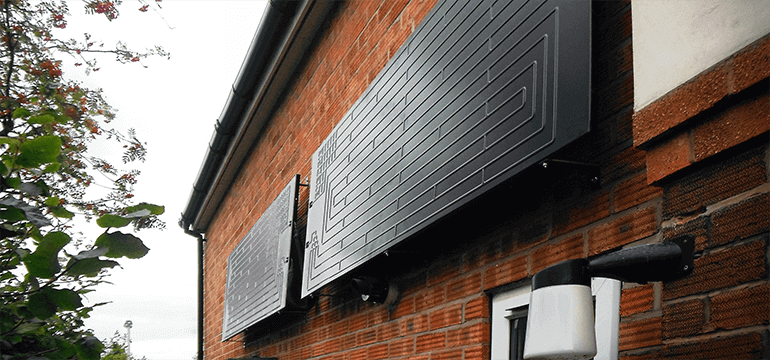
What Types of Mounting Systems Are Available?
Unless stacking them, thermodynamic panels are usually fitted on six legs that keep them around 15 centimetres away from the wall. The metal legs keep the panel tight and secure, even in stormy weather, regardless of the placement of the thermodynamic panel. While this can also be done on the roof, some choose to install them on metal beams instead.
Similarly to solar panel racking systems, there are also options for using A-racks or pitched mounts that elevate the panel towards the sun in order to tap on even more warmth. When thermodynamic panels are used for more consuming appliances, such as a heated swimming pool, with the intention of saving roof space or because of a lack of much space, it is also possible to get stacked mounts. These most often fix the array of panels on the two ends but it is also possible to balance the weight in the middle of the panels. If required, stack mounts can be reinforced on the sides too.
How Do You Operate the System?
Since the thermodynamic water heating system is relatively simple, there is only one control unit on the compressor; all other components work without having to adjust them regularly. The control unit displays the status of the system, i.e., whether the compressor is running, what the water temperature is, and what is the progress of heating up the full tank.
Under regular conditions, the system works by itself, without having to set anything. If you go on vacation, it is a good idea though to turn the system off so that it does not use electricity in vain. When returning, you can turn on the anti-legionella boost that heats up the water to a higher level using the compressor in order to kill any bacteria that might have appeared in the stale water.
This boost can also be used by a single button press if the entire tank of hot water has been used up because of extraordinary hot water usage—for example, when hosting guests. Turning on the boost will use the compressor to quickly reheat the water. Once it has reached the optimal temperature, the boost switches off automatically.
Some thermodynamic systems have the option of setting operating hours so that the compressor turns off during night, for example. Using such an option can save you £4-5 a month, and also prolongs the lifespan of the compressor.
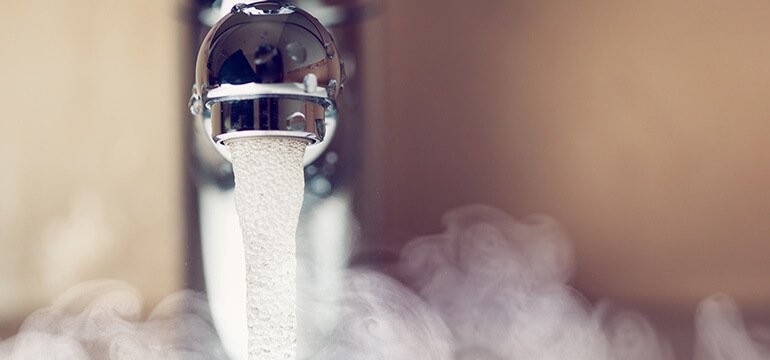
What Maintenance Is Required?
As a result of the simple, sustainable product design, thermodynamic water heating systems need little maintenance. Since the refrigerant fluid circulates in a closed cycle, and does not degrade over time, so there is no need for refuelling.
Infrequent check-ups—once or twice every 10 years—may be beneficial to keep the system up and running in the long run, without any problems. Should the compressor fail, it is repairable or replaceable for a price starting at £150.
The water tank that is connected to the system should be maintained as any other water tank: depending on the hardness of the water, it needs to be flushed every few months down to once a year. This should be done to prevent limescale build-up.
The thermodynamic panels themselves may be cleaned once in awhile, depending on the weather conditions. They require no special cleaning supplies and the washing is only supposed to keep materials off the panel so that the entire ambient temperature reaches the panel, having it operate the most efficiently. This is an optional step if the panels are cleansed well enough by frequent rain.
This way, thermodynamic water heating is an excellent way of reducing your bills and your carbon footprint at the same time, without needing to spend much time or money on maintaining the system—it will be available for you at all times.
Find the Best Thermodynamic Panel Suppliers
Thermodynamic hot water systems are an exceptional investment for your home that improves the quality of your everyday life by reducing costs and increasing your convenience, without having to worry about any negative environmental effects. This new technology revolutionises how you can manage your domestic hot water needs.
To learn more about how you can utilise the power of thermodynamic panels, all you need to do is to click the button below and you will receive up to 3 personalised quotes. This service is free and without obligations.
- Quotes from local engineers
- Payment by finance available
- Save up to £729 per year
It only takes 30 seconds




Attila is the UX Manager at GreenMatch. He holds a degree in international business with four years of coordination experience in marketing, user experience, and content creation. Attila likes to write about solar energy, heating technology, environmental protection, and sustainability. His and his team’s articles appeared in well-known sites such as The Conversation, Earth911, EcoWatch, and Gizmodo.
 We strive to connect our customers with the right product and supplier. Would you like to be part of GreenMatch?
We strive to connect our customers with the right product and supplier. Would you like to be part of GreenMatch? - Thermodynamic Panels
- Cost-Effective Water Heating Using Thermodynamic Panels
- How Much Do Thermodynamic Panels Cost?
- How Much Money Can You Save?
- Where Can Thermodynamic Panels Be Installed?
- What Types of Mounting Systems Are Available?
- How Do You Operate the System?
- What Maintenance Is Required?
- Find the Best Thermodynamic Panel Suppliers

